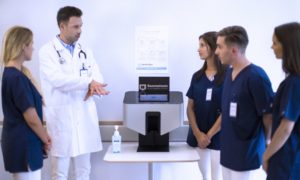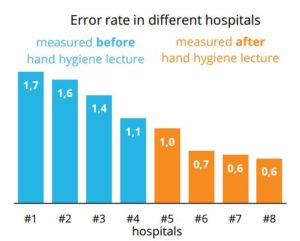Challenge: To teach perfect hand hygiene to everyone.
Solution: Semmelweis Scanner also suitable for medical teaching universities, hospitals, nursing homes or private healthcare centers.
Our goal is to teach perfect hand hygiene to everyone, and the first step is to routinely employ evidence-based, objective assessment methods regarding hand hygiene performance.
 Identifying typical skin areas subject to poor hand hygiene can help improving personal technique. Only complete disinfection of the hands results in maximized patient safety.
Identifying typical skin areas subject to poor hand hygiene can help improving personal technique. Only complete disinfection of the hands results in maximized patient safety.
Our scanner has been an integral part of Semmelweis University’s medical doctoral training program since 2012. Semmelweis University is the oldest medical school in Hungary, with more than 10,000 students. Surgical students cannot pass their course exam without demonstrating an errorless hand rubbing, validated by the Semmelweis Scanner. The method has been included in the Surgical Techniques textbook [Semmelweis Publishing, ISBN: 9789633310908, 2015].

Ongoing education and training plays a vital role in improving hand hygiene compliance and technique of the clinical staff. In Hungary, we created a unique & comprehensive hand hygiene program with our partners, including accredited training for nurses. Within the frames of this cooperative program, 1800 employees in 19 hospitals were certified during the first year.
Our results show that even a one-time hand hygiene training has a profound positive impact on the healthcare workers’ hand hygiene performance [T. Haidegger at al.: In the footprints of Semmelweis: A Multi-Institutional Study on the Efficacy of Hand Rubbing, 43rd Conf. of the Association for Professionals in Infection Control and Epidemiology (APIC), Charlotte, NC, ID:6-164, 2016]. Error rate (total number of missed areas / participants) was investigated before or after the training. We experienced a significant difference between the two groups.

The Semmelweis Scanner in an excellent tool to teach and validate incoming new staff members’ skills, and it can also be used efficiently during regular (e.g., annual) hand hygiene trainings. These practical trainings help to maintain high-quality service.